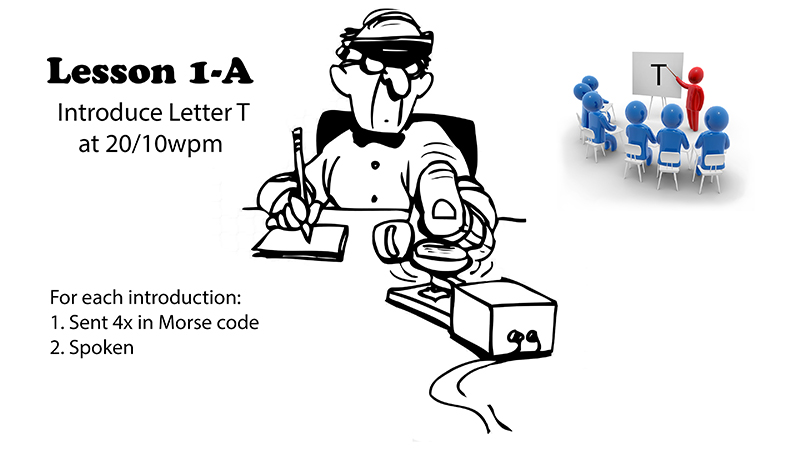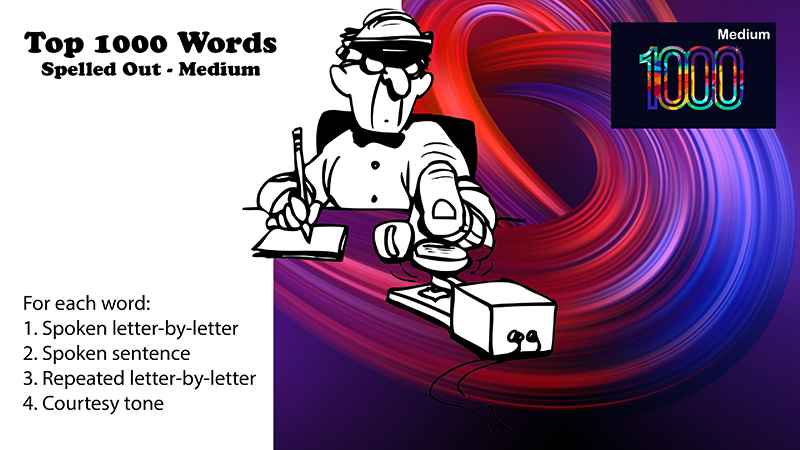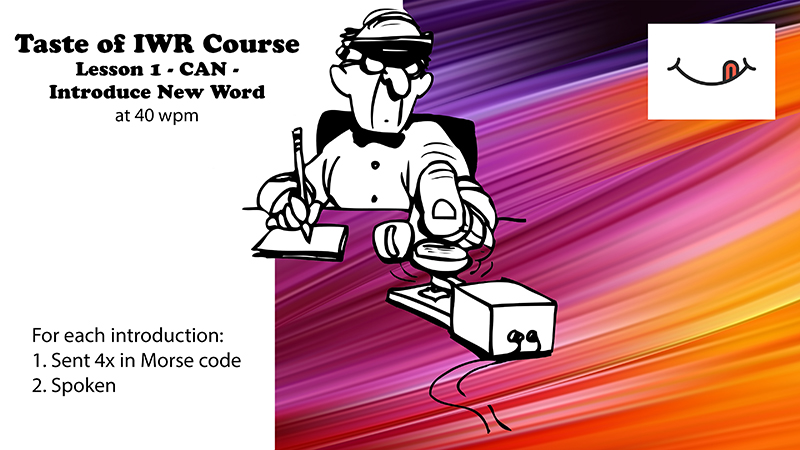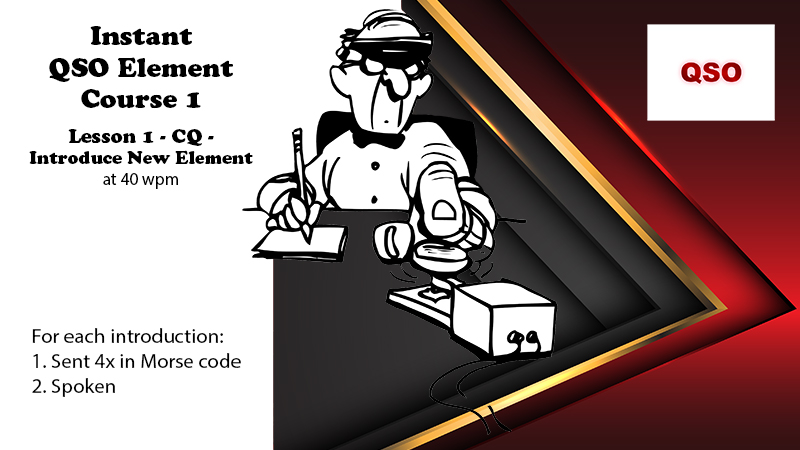Getting Started
| Table of Contents: |
Morse Code Course:
 Welcome to my Morse Code Course! I created this course as a set of YouTube videos using the Farnsworth method. Each video has a character speed of 20wpm and an overall speed of 10wpm. The course provides continuous and immediate feedback, which will help accelerate your learning. Practice callsigns are or were valid US callsigns. Words are limited to the Top 5,000 words that are at most four letters long, and a focus was placed on selecting words that match the current letter. Words and callsigns will only contain characters that have been introduced so far.
Welcome to my Morse Code Course! I created this course as a set of YouTube videos using the Farnsworth method. Each video has a character speed of 20wpm and an overall speed of 10wpm. The course provides continuous and immediate feedback, which will help accelerate your learning. Practice callsigns are or were valid US callsigns. Words are limited to the Top 5,000 words that are at most four letters long, and a focus was placed on selecting words that match the current letter. Words and callsigns will only contain characters that have been introduced so far.
It may be more challenging initially, but I recommend trying to head copy everything. Copying callsigns might be the exception since most hams record the callsigns in their logbook, but it will help you if you can master it. The course is incremental and provides an opportunity to develop this skill from the very start!
Guidelines to maximize your results:
- Use each lesson in order. Each lesson builds off of the next.
- Simply listen to the introduction videos to gain familiarity with the new character. For all other videos, in the 1-second pause, say out loud whatever you can copy.
- Move on to the next lesson as soon as you reach 70-90% accuracy. Don't be concerned with finishing each lesson. I have generated more content than most students will need for mastery of any particular lesson. The first few lessons will not take much time to get through.
- Practice more frequently in shorter intervals, rather than less frequent and longer sessions. Perhaps consider practicing twice a day, morning and evening, for 15 minutes in each session.
- Do not count the dits and dahs. Listen to the entire sound pattern of the characters. Avoid having a lookup table of dits and dahs in your head, and avoid repeating the sound pattern in your head.
- Consider turning on Closed Captioning. See and hear the answer!
- If you can easily count the dits and dahs, you need to learn at a faster rate. Listen to the videos at 125% or 150% speed, which is 25/13wpm and 30/15wpm, respectively. (On YouTube, click the gear icon, next click the Playback Speed, and then select the desired speed.)
- Protect your hearing! Listen to Morse code at the lowest usable volume, especially if using headphones.
- If using speakers instead of headphones, you may encounter a slight increase in difficulty because of echo and timing differences. Avoid listening to Morse code in a confined space with perceivable echo. And consider shifting the audio balance so that only one speaker is used.
Considerations:
It is somewhat common for some students to have difficulty starting to copy Words and Callsign in the course. The two and three-character practice sets are rendered with a space between the characters, whereas the words are not—E.g., the difference between C A T versus CAT. Everything is at the stated speed of Farnsworth speed, but in practice, there is a noticeable bump in speed since character spacing is shorter than word spacing. The intent was to enable students to reach a full 20/25/30wpm by the end of the course and to start having students work on bumping up the speed within the course and not all at the end.
Since creating the course, I have learned time and time again that not everyone takes the same journey to mastery. Some students need additional stepping stones. In the existing course, some students do just fine, but not all students can make that initial jump in speed without considerable difficulty.
If you have excessive difficulty, I recommend treating the Word and Callsign practice sets as optional. You can always work on mastering ICR after learning all the characters. I have many practice sets to help students master ICR after learning the characters. (If you want to give it a go without skipping them, you can continue in the course as if you were going to skip them but spend 3 to 5 minutes each day with the first Word practice set. Move on to the next one as soon as you start having success with it.)
Learning ICR is the most challenging skill in mastering Morse Code at speeds of 20+wpm, which is needed to head-copy at a standard 20wpm. With that in mind, I created a Next-Generation Morse Code Course to try and address this issue. It has every conceivable stepping stone to get students up to standard speed at 20/25/30wpm. I have not released it because it isn't ready for prime time yet. If you'd like to try it out, don't hesitate to contact me, and I will provide a download link. I appreciate any feedback to assist in refining it. Also, note that it introduces characters in the same order so that you can jump back and forth between both courses.
Additional Playback Options:
I have created a YouTube Playlists for this course for those who prefer to keep track of their progress all within YouTube — (20/10, 25/10, and 30/10wpm). Otherwise, use the table below to jump to the appropriate video.
If you would prefer to use this course as a Podcast, you can use the following URLs. Note that this is a private podcast and cannot be found searching the catalog/library of your favorite podcast app. See this page for details on configuring your device.
- 20/10wpm - https://morsecode.ninja/podcasts/feeds/course-20-10wpm.rss
- 25/10wpm - https://morsecode.ninja/podcasts/feeds/course-25-10wpm.rss
- 30/10wpm - https://morsecode.ninja/podcasts/feeds/course-30-10wpm.rss
If you would prefer to have audio files to listen to on your device, you may download ZIP files. Choose the speed that is best for you — 20/10wpm, 25/10wpm, and 30/10wpm. Each ZIP file contains the course as MP4/M4A files encoded with AAC. These files will playback on current operating systems and handheld devices. But Android users may need to download a compatible player from the App store. There are several free players available for Android devices. To be most useful, your player should save your spot and allow you to continue when you come back to it.
If you need this course in MP3 format because of an older device, you can download it as a 20/10wpm Farnsworth speed zip file. Please be aware that it is an 5.7GB download and it uncompresses to 17.3GB.
I wish you all the best on your Morse code journey! If you have any questions, or comments feel free to reach out to me. My contact details are here.
| Jump To: |
| T A E N O i S 1 4 R H D L 2 5 C U M W 3 6 ? F Y P G 7 9 / B V K J 8 0 <BT> X Q Z <BK> Period (Ramp Up) |
20/10wpm:
Once you complete the Morse Code Ninja course, you are ready to move on to developing your ICR (Instant Character Recognition). Check out the Practice page, which has 250+ unique practice sets.
I recommend continuing to push overall speed to improve ICR (Instant Character Recognition) and specifically initially using the following practice sets:
- Single Letter-Number - Rapid-Fire
- Single Letter-Number - Mind-Melt
- Two Letter Words
- Three Letter Words
- Top Two Letter Combinations in Words
- Top Three Letter Combinations in Words
- US States
- Top 100 Words
- Top 200 Words
Farnsworth timing can help move them from nonstandard to standard timing when the above recommendation is too big of a step. In this case, use the 8x, 6x, 4x, 3x, and 2x character spacing for each of the Top 100, 200, 300, and 500 Word practice sets. E.g., "8x Character Spacing - Top 100 Words." (You can quickly find these practice sets under the Farnsworth filter.) Work your way down from the larger 8x spacing through 2x and then down to standard timing.
If you made your way through the course, I would be delighted to know! Feel free to let me know.
Learn to Follow Letter-by-Letter:
 ICR (Instant Character Recognition) is not enough to learn to head copy sentences. It also requires developing the mental dynamics to follow letter-by-letter to form words and then build up sentences and infer meaning.
ICR (Instant Character Recognition) is not enough to learn to head copy sentences. It also requires developing the mental dynamics to follow letter-by-letter to form words and then build up sentences and infer meaning.
It is common for people to learn ICR at the same time as they develop the mental dynamics necessary to follow a ragchew. The approach is similar to learning to keyboard-copy while learning to touch type. While many have successfully learned both skills simultaneously, you may benefit from studying each in isolation before bringing the two skills together.
The following practice sets will help you learn the mental dynamics of head copy without using Morse Code. Additionally, these practice sets can be used as a warm-up before practicing Morse code. Try practicing for 5 minutes before jumping into your regular practice. (If copying individual words from the Top 1000 Words is easy, try copying sentences.)
You may also use these practice sets as a diagnostic tool. If one's ICR is too slow or consumes mental/conscious bandwidth, then there is not enough room to determine words, sentences, and meaning. One indication of this problem is what I call Word Dropping, which is when you successfully copy a word and immediately forget what it was as you struggle to copy the next incoming word. If you find these practice sets easy but struggle to copy a sentence in Morse code, you need to focus on improving your ICR proficiency.
To listen to the audio files on your device, you may download this ZIP file. It contains MP4/M4A files encoded with AAC. These files will playback on current operating systems and handheld devices. But Android users may need to download a compatible player from the App store. There are several free players available for Android devices. To be most useful, your player should save your spot and allow you to continue when you come back to it.
| Top 1000 Words | 1 | Extra Slow | With Repeats |
| 2 | Slow | ||
| 3 | Medium | ||
| 4 | Fast | ||
| 5 | Extra Fast | ||
| 6 | Extra Slow | No Repeats | |
| 7 | Slow | ||
| 8 | Medium | ||
| 9 | Fast | ||
| 10 | Extra Fast |
| Sentences from Top 100 Words | 1 | Extra Slow | With Repeats |
| 2 | Slow | ||
| 3 | Medium | ||
| 4 | Fast | ||
| 5 | Extra Fast | ||
| 6 | Extra Slow | No Repeats | |
| 7 | Slow | ||
| 8 | Medium | ||
| 9 | Fast | ||
| 10 | Extra Fast | ||
| Sentences from Top 300 Words | 11 | Extra Slow | With Repeats |
| 12 | Slow | ||
| 13 | Medium | ||
| 14 | Fast | ||
| 15 | Extra Fast | ||
| 16 | Extra Slow | No Repeats | |
| 17 | Slow | ||
| 18 | Medium | ||
| 19 | Fast | ||
| 20 | Extra Fast | ||
| Sentences from Top 500 Words | 21 | Extra Slow | With Repeats |
| 22 | Slow | ||
| 23 | Medium | ||
| 24 | Fast | ||
| 25 | Extra Fast | ||
| 26 | Extra Slow | No Repeats | |
| 27 | Slow | ||
| 28 | Medium | ||
| 29 | Fast | ||
| 30 | Extra Fast |
Taste of IWR Course:
 This innovative course introduces you to IWR (Instant Word Recognition) and can accelerate your learning of ICR (Instant Character Recognition). IWR and ICR are similar. Rather than recognizing the sound patterns of individual characters in ICR, you hear the entire word as a complete sound pattern and instantly identify the word in IWR. (Even if you haven't mastered ICR, you can start this course! Don't be intimidated by the speed. It is entirely doable.)
This innovative course introduces you to IWR (Instant Word Recognition) and can accelerate your learning of ICR (Instant Character Recognition). IWR and ICR are similar. Rather than recognizing the sound patterns of individual characters in ICR, you hear the entire word as a complete sound pattern and instantly identify the word in IWR. (Even if you haven't mastered ICR, you can start this course! Don't be intimidated by the speed. It is entirely doable.)
In this course, you will learn the sound pattern of 25 words. For each word introduced, there are four practice sets of increasing difficulty:
- Introduce New Word
- Single Word Repeated 3x
- Single Word
- Two Words
You only need to listen long enough to get a gist of the new word in the Introduce New Word audio file. Feel free to return to it if you need a refresher on that word. The Single Word Repeated 3x will play each word randomly three times before speaking the answer. The single word will play each word once before speaking the answer. The Two Words audio file will give you two random words in a row with a second of space between them. (The new word is randomly selected 40% of the time to help you focus and learn it.)
Once you have made it through the 100 lessons and learned the sound pattern of the 25 words, it is time to put your IWR skills together to copy sentences! Lessons 101 through 106 will walk you from copying at 8x Word Spacing to a standard 40wpm! At 8x spacing, we start with a spacing slightly larger than what you were working with in the Two Words practice set. Then we step down to 6x, 4x, 3x, 2x, and finally to standard word spacing.
Advice:
Make the practice active and speak your answer out loud. Also, try and make a guess on the word, even if you aren’t sure. The attempt and instant feedback will increase your learning efficiency.
You may find a strong tendency to want to focus on the characters. Just relax and try and let go. (I know it can be easier said than done.) This tendency may be especially strong in those with a firm grasp of ICR (Instant Character Recognition). It may be helpful to engage in a lightly distracting activity, such as petting your dog or cat or perhaps watching an easy-going YouTube video with the sound off. This problem is analogous to the challenge of learning ICR after first learning to count dits and dahs. It may also take several attempts over a few days to get some initial success. Longer practice sessions are not necessarily better.
If you have some proficiency with ICR, avoid getting overly concerned if you find yourself using ICR and IWR. It is normal to use multiple forms of copy simultaneously. Often people will copy the beginning or ending parts of a word using ICR, especially at the beginning of a sentence and when anticipating uncommon words. While focusing on learning IWR, the key is to refrain from attempting to copy every character with ICR.
The basis for the course:
Below are 25 common words that can be learned at 40 wpm. Why 40wpm? This is fast enough for beginners not to recognize characters and fast enough that even the longest word can be learned as a sound pattern. (ABOUT takes 1.17 seconds to send at 40wpm, while WOULD takes 1.08 seconds to send.) 40wpm is also a middle-of-the-road speed. IWR is easiest between 35 to 50wpm for most people. Beyond 50wpm and the sound pattern tends to sound muddled because Morse code loses its signature tone and takes on more of a pulsating sound.
CAN, NOT, HERE, BAD, HOW, THERE, DO, DID, MORE, LIKE, HER, GET, WHAT, TELL, SHE, TO, YOU, WILL, ME, WHERE, IT, IS, KNOW, WOULD, ABOUT
This course is designed so that students learn to distinguish between two initial words based on their sound patterns. Once you reach 75% correct, move to the next lesson, which adds a new word. Each new lesson adds an additional word, and that new word has a 40% probability of being randomly selected. By moving from lesson to lesson, you expand your vocabulary of word sound patterns.
My intuition is that earlier exposure to learning the sound pattern of words will accelerate the overall learning of ICR, even if QRQ isn't your goal. And anecdotally, there are references in historical texts to young boys who would learn to recognize certain words and phrases at the foot of their telegrapher father without knowing how to distinguish characters. These boys would later go on to quickly learn CW and excel in the profession. Below is one such reference.
The Art and Skill of Radio-Telegraphy (N0HFF) page 98 and 99:
The fastest code learner we have ever heard of so far started code practice for the examination just one week before he took the test and passed it! You say: “Wait a minute. What goes on here?” You’re right, there is a history behind this achievement. What was it, and what can we learn from it?
It was his conditioning, his background. That played a crucial part. His father was a skilled telegrapher at a country railroad station. His earliest childhood memories were of sitting, fascinated, on the floor in his father’s telegraph office, listening to the sounder clicking. Unconsciously he learned to recognize when his Dad’s station was being called, and when he did, he would go to get his Dad. It was only after he was quite a bit older that he realized that not all adult men could automatically read Morse code in the same way that they could read and write English!
You might consider reading the book. It is free and a great read!
Course Content:
I have created a YouTube PlayList for this course for those who prefer to keep track of their progress all within YouTube.
If you would prefer to use this course as a Podcast, you can use the following URL. Note that this is a private podcast and cannot be found searching the catalog/library of your favorite podcast app. See this page for details on configuring your device.
If you would prefer to have audio files to listen to on your device, you may download the course as a ZIP file. The audio files are MP4/M4A files encoded with AAC. These files will playback on current operating systems and handheld devices. But Android users may need to download a compatible player from the App store. There are several free players available for Android devices. To be most useful, your player should save your spot and allow you to continue when you come back to it.
| Jump To: |
| CAN NOT HERE BAD HOW THERE DO DID MORE LIKE HER GET WHAT TELL SHE TO YOU WILL ME WHERE IT IS KNOW WOULD ABOUT (Review of All Words) (Sentences) |
If you made your way through the course, I would be delighted to know! Feel free to let me know.
Instant QSO Element Courses:
 This innovative course series teaches you the 100 most common QSO elements using IWR (Instant Word Recognition). Learning these QSO elements will reduce the burden of copying an entire QSO using ICR (Instant Character Recognition).
This innovative course series teaches you the 100 most common QSO elements using IWR (Instant Word Recognition). Learning these QSO elements will reduce the burden of copying an entire QSO using ICR (Instant Character Recognition).
IWR and ICR are similar. Rather than recognizing the sound patterns of individual characters in ICR, you hear the entire word as a complete sound pattern and instantly identify the word in IWR. (Even if you haven't mastered ICR, you can start this course! Don't be intimidated by the speed. It is entirely doable.)
It is common to use ICR and IWR at the same time. Depending on your ICR proficiency, you may find yourself copying some elements with ICR and IWR simultaneously. With less proficiency, you might only copy with IWR. Don't worry. Either way is acceptable.
Each course will teach the sound pattern of 25 common abbreviations and Q-Codes found in QSOs. For each element introduced, there are four practice sets of increasing difficulty:
- Introduce New Element
- Single Element Repeated 3x
- Single Element
- Two Elements
You only need to listen long enough to get a gist of the QSO element in the Introduction audio file. Feel free to return to it if you need a refresher on that element. The Single Element Repeated 3x will play each element randomly three times before speaking the answer. The single element will play each element once before speaking the answer. The Two Elements audio file will give you two random elements in a row with just enough space between them to quickly speak each answer. (The new element is randomly selected 40% of the time to help you focus and learn it.)
Once you have make it through the 100 lessons and learned the sound pattern of the 25 elements, continue with the "Review Course Elements." Finally, in Courses 2 thru 4, the "Review All Elements" will include elements from all previous course(s). Note that each course is largely independent of each other.
It is helpful to work with several lessons in the same practice session and slide down one to three lessons in the next session. For example, if you are working with Lessons 36 thru 41 today, you might work with Lessons 38 thru 43 in tomorrow's practice session.
Alternatives:
If you would prefer to use this course as a Podcast, you can use the following URLs. Note that this is a private podcast and cannot be found searching the catalog/library of your favorite podcast app. See this page for details on configuring your device.
- Course 1 - https://morsecode.ninja/podcasts/feeds/instant-qso-element-course-1.rss
- Course 2 - https://morsecode.ninja/podcasts/feeds/instant-qso-element-course-2.rss
- Course 3 - https://morsecode.ninja/podcasts/feeds/instant-qso-element-course-3.rss
- Course 4 - https://morsecode.ninja/podcasts/feeds/instant-qso-element-course-4.rss
If you would prefer to have audio files to listen to on your device or prefer a slightly faster or slower speed, you may download the courses as a ZIP file: 35wpm, 40wpm, 45wpm, and 50wpm. The audio files are MP4/M4A files encoded with AAC. These files will playback on current operating systems and handheld devices. But Android users may need to download a compatible player from the App store. There are several free players available for Android devices. To be most useful, your player should save your spot and allow you to continue when you come back to it.
Have fun!
| Jump To: |
| CQ 599 5NN 559 UP 73 RST NR DE NAME VY ES WX QRZ QRM UR TEST AGN GA GM GE FER TU (HI HI) QTH (Review Course Elements) |
